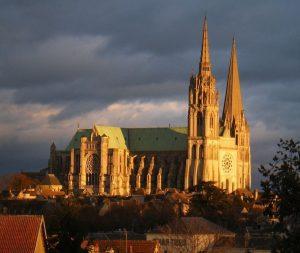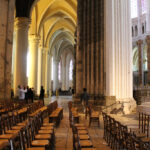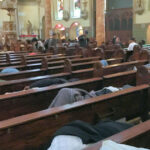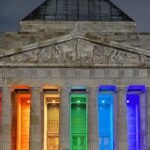
Sacred Space and the Trivialisation of God
Have you noticed? Most new evangelical churches in the West today are deliberately being made NOT to look like a church. They look just like any other building – and that is being done on purpose. There is nothing about the building to indicate that it might in fact be a place of Christian worship.
For example, almost always there is no cross to be found anywhere. And even the name is designed to play down any Christian connotation. Thus we have things like ‘CityLife’ or ‘OceanView’ or ‘RiverSide’ or some other nondescript name. Gone are the days of the ‘First Baptist Church’ or the ‘Park Street Lutheran Church,’ etc.
 And of course things are just the same inside: you would have no idea the building is a house of worship. It looks a lot like a nightclub or a disco, complete with black walls, strobe lights, and smoke machines! And don’t forget the mandatory café. Now many people will choose a church based on who has the spiffiest and most expensive coffee machines!
And of course things are just the same inside: you would have no idea the building is a house of worship. It looks a lot like a nightclub or a disco, complete with black walls, strobe lights, and smoke machines! And don’t forget the mandatory café. Now many people will choose a church based on who has the spiffiest and most expensive coffee machines!
All this is being done – it is claimed – to help bring in non-Christians; to make the church more seeker-sensitive; and to not scare away prospective visitors. We want to play down any Christian symbolism and messaging, in order to make things less scary for the non-Christian. At least those are the sorts of claims being made.
But are these folks right? Are these sorts of strategies really serving the gospel, bringing in non-believers, and winning the lost? One can ask some real hard questions here. As far as the seeker-sensitive service goes, some of those most heavily into this over the years have now come out and admitted that this has really been a failed strategy.
As I wrote in a 2007 article concerning Bill Hybels and the Willow Creek Community Church, it just has not lived up to all the hype: https://billmuehlenberg.com/2007/10/31/a-major-rethink-on-church-growth/
I write all this in light of the Notre Dame fire, and recent church attacks. I already penned an entire piece to say that yes of course, God lives in the hearts of his people, not in buildings. However, there is a place for the Christian to appreciate great art, including great architecture and great cathedrals. See that earlier piece here: https://billmuehlenberg.com/2019/04/17/cathedrals-catholics-and-christianity/
But I was reminded again of all this when I was revisiting a great book penned by R. C. Sproul, The Holiness of God. I have already used it in several recent pieces, including this one: https://billmuehlenberg.com/2019/04/24/sproul-on-gods-holy-justice/
The last chapter in that superb book is entitled “Holy Space and Holy Time”. In it he reminds us of the importance of seeing God as who he really is: holy and transcendent. Sure, he is also personal and immanent, especially through Christ. And for that we should all be so very thankful. See here for more on this: https://billmuehlenberg.com/2013/08/05/on-gods-immanence-and-transcendence/
But modern Christians have tended to lose sight of God’s transcendence and his holiness. We have tended to trivialise God and make him just like one of us, instead of who he really is. Sproul also looks at the issue of church architecture and why it matters. His words show us why we may be doing God a real disservice with our dumbed-downed and desacralised church buildings.
He says this: “Humanity seems to be incurably homo religiosis.” He explains: “people have always looked for a window or door to the transcendent. We seek a threshold that will lead us over the border from the profane to the sacred. It is a quest for sacred space, for ground that is holy ground.”
He looks at various Old Testament theophanies and appearances of God, including the episode of Moses at the Burning Bush. He writes: “In Moses’ encounter with God in the wilderness, he experienced a threshold to holy space.” He continues:
The holy space Moses occupied was made holy by God’s presence. The composition of the earth at this spot was no different from the earth on the rest of the desert floor. The sacred character of this spot was not intrinsic but extrinsic. That is, it was made sacred by a super-added presence. The event that occurred there loaned an extraordinary dimension to the ordinary. The common space had become uncommon by virtue of God’s appearance at that spot.
Yes, that is such an important point, especially for contemporary Western Christians to keep in mind. Sproul then looks at the matter of church buildings. Yes, he acknowledges that the church is made up of God’s people, not just buildings. However, he continues:
Church architecture varies. Every church building communicates some kind of nonverbal message. In the past, the Gothic cathedral was designed to focus attention on God’s transcendence. The use of high ceilings, vaulted space, towers, and spires all served to communicate that in this building, people met with the holy. While some contemporary church buildings still use spires and vaulted ceilings to suggest God’s awesome holiness, other church buildings have been designed to create a fellowship facility. These churches can look more like town meeting halls or even theaters. In some of these churches, the sanctuary becomes a stage, and the congregation becomes an audience. The trend may be seen as a profanation of sacred space to remove any discomfort suggested by the presence and the terror of our holy God. In these settings people are comfortable with other people as they enjoy fellowship with one another.
What is often lost in these functional church designs is the profound sense of threshold. A threshold is a place of transition. It signals a change from one realm to another….


I could close here and again recommend that you all get his book and study it carefully. But just today in my news feed I saw that the latest Breakpoint article by John Stonestreet and G. Shane Morris deals with this very same topic. Entitled “Sacred Spaces Matter,” and with this subtitle, “Beauty Calls the World to God,” it makes the same points that Sproul had made. Let me quote the second half of his article.
Godless governments, racists, radical Islamists, and common arsonists seem to understand that places matter, especially sacred spaces. But before the smoke had even cleared above Notre Dame last week, well-meaning Christians took to social media to remind us that the Church isn’t a building, it’s a people.
Of course, that’s true… in the same way that a family isn’t a house. But that doesn’t make it less tragic, painful, or awful when someone’s house burns down! Why are so many, especially evangelical Christian, so quick to dismiss the importance and value of tangible beauty and creative expression, including sacred space?
Since the very first days of the early church, Christians have struggled with the temptation to stray into a Gnostic way of thinking. Gnosticism takes various forms, but believes that the material world is ultimately bad, and therefore only “spiritual” things matter.
Terrorists, racists, and vandals attack sacred space because of what it means, not only to those who worship but to the histories of the communities in which they exist. Sacred space is defined by a purpose, set aside for the worship of God. When the early Christians were finally free to publicly worship, they responded by setting aside space for corporate and individual worship, some that are amazing feats of architecture and design. For two millennia Christians sought to fill these spaces with beauty—in art, song, and in reverence. It’s an amazing heritage.
The fact that so many churches today are seen primarily as functional spaces, and therefore made to look like shopping malls or performance venues, suggests that we’ve lost something. Charles Taylor called it “disenchantment.” That’s a fancy way of describing how a sacramental view of reality has been replaced by an efficient, functional view.
Of course, true worship often happens in plain, simple buildings. The book of Acts describes a pretty amazing worship service once held in a Philippian jail. Still, the human impulse to beautify spaces, and to mourn the loss of spaces points to a truth about God and ourselves.Russian novelist Fyodor Dostoyevsky may have overstated it when he said “beauty will save the world,” but to downplay the loss of beauty is to miss something very important about ourselves and our world.
No, buildings aren’t the Church. But in a time when attacking church buildings has become a favorite means of attacking God, His people, and even cultural order, we should never forget what even arsonists and vandals know: that beauty matters, and stones can sometimes preach.
http://www.breakpoint.org/2019/04/breakpoint-sacred-spaces-matter/
Quite so. In an age in which God is being trivialised and the sacred is being profaned, Christians of all people should be resolutely resisting this trend. And that would include the temptation to make our churches look like just any old pagan disco or nightclub.
Let me finish with some words by Donald McCullough from his important 1995 volume, The Trivialization of God. In his opening chapter he says this:
Visit a church on Sunday morning – almost any will do – and you will likely find a congregation comfortably relating to a deity who fits nicely within precise doctrinal positions, or who lends almighty support to social crusades, or who conforms to individual spiritual experiences. But you will not likely find much awe or sense of mystery. The only sweaty palms will be those of the preacher unsure whether the sermon will go over; the only shaking knees will be those of the soloist about to sing the offertory.
The New Testament warns us, “offer to God an acceptable worship with reverence and awe; for indeed our God is a consuming fire” (Hebrews 12: 28-29). But reverence and awe have often been replaced by a yawn of familiarity. The consuming fire has been domesticated into a candle flame, adding a bit of religious atmosphere, perhaps, but no heat, no blinding light, no power for purification…. The worst sin of the church at the end of the twentieth century has been the trivialization of God.
And how many contemporary church buildings and services contribute greatly to this trivialisation?
(Australians will find Sproul’s book at Koorong: https://www.koorong.com/search/product/the-holiness-of-god-the-character-of-god/0842339655.jhtml )
[1687 words]




















Bill, I must confess that I never considered it from this point of view. I always thought large churches, especially those that appeal to the so-called ridiculous, “seeker-friendly” types to just be purchasing and setting up ‘shop’ in huge, non-descript, buildings because they were large enough to accommodate all those folk who seem to view Christianity as though it were a social club. I know so very many people who attend these kinds of places. Thank you for opening my eyes to what exactly this is really about.
Thanks Marissa. Yes, as always there are various unhelpful extremes we need to avoid. One is a Philistine attitude which disdains all great art and great architecture. Another is failing to understand the holy God whom we worship, and showing all due reverence and respect as we do worship him. Another is to idolise and misuse great architecture and cathedrals, and venerate the art instead of God. All three mistakes need to be avoided.
I agree with what you said Bill. The sense of majesty conveyed by the building relates to the esteem of God of the church.
To build a cathedral (like St John’s in Brisbane) would cost many millions of dollars and take many years to complete.
We can build a nondescript tilt-slab auditorium for a fraction of the cost that could hold many more worshippers (cynically – paying customers). We can let the band and the lights and the smoke machines convey the mood, not the Spirit of God. It is cheap to maintain and like Judas, we can claim that the money we save could be better spent on the poor etc (and that is valid to a degree) thereby getting us some piety cred with other like-minded believers and let the pagan world know that we are aiming to welcome them in by looking like their environment.
As you described it, why would a ‘Christian’ nightclub be attractive to the un-churched when they can go to a real one?
I always understood church to be for believers, not unbelievers. We go there to be challenged, encouraged and strengthened (as well as to worship God), to go out into the world to share the Good News with them. Then they can come as believers.
It is a bit like a conservative government moving to the left to attract voters who will never vote for them. The late evangelist from NZ, Barry Smith was once told he was stroking the cat the wrong way. He replied, “let the cat turn around.”
I don’t know the answer as I suspect a lot revolves around money.
Thanks Troy. Yes that raises another matter here that bears discussing. Should we spend a lot of money on great places of worship – money that might have gone to the poor? Those and related questions I briefly dealt with in my earlier piece in which I said:
https://billmuehlenberg.com/2019/04/20/on-restoring-notre-dame/
G’day Bill,
Not far from where we live is an old property, Newstead Station. Established in the 1930’s the Newstead woodshed is famous in Tom Robert’s painting, ‘The Golden Fleece.’ That woodshed, made of bush timber, still stands. Not far away from the shed is the ruins of a small brick Presbyterian church. Sadly, it was burnt down many years ago. But the Anderson family who established Newstead had their priorities right. Their woodshed and workplace was of rough-hewn bush timber. But their place to worship God of brick. Their best for their God.
Andrew Campbell
Thanks Andrew.
As an immigrant and a Pom, I come from the land of majestic buildings. Even when we went back to visit, we took the time to see one or two of these majestic churches and I like the Sunday Songs of Praise on the ABC because of the opportunity to see these churches in their splendour again.
Having said that I have no attraction to such buildings in terms of worship but I can’t ignore the fact that when you enter them there is a certain dimension that you don’t get in other types of buildings.
I like to imagine God falling in all his glory in such a building as there would be plenty of room for the angels to enter and sing his praises.
We are instructed to worship God with reverence and awe and these modern churches reduce God to “a mate you have a beer with” level of familiarity. It’s not right and I believe reduces respect for Christians in the broader community. Very sad.
A couple of multi-faith building possibilities for Notre Dame..
https://cdn.newspunch.com/wp-content/uploads/2019/04/Norte-Dame-refitted-1170×780-1024×683.jpg
https://assets.lifesitenews.com/images/made/images/remote/https_www.lifesitenews.com/images/local/notre_dame_redesign_810_500_75_s_c1.jpg
Bill above referred to ‘Bill Hybels and the Willow Creek Community Church’.
If you are not familiar with the current status, this link provides an update.
https://www.christianitytoday.com/news/2019/february/willow-creek-bill-hybels-investigation-iag-report.html
Sad.
Dear Bill,
Thank you for the article. I detect some sadness in it as you write that modern church buildings are no longer built with the intention of lifting hearts and minds to the majesty of God. I feel it too! Even the new Catholic Churches will never inspire like the old Gothic Cathedrals like Notre Dame do. However, the new Catholic Churches though modern always contain certain features such as statues of the Sacred heart, the Holy Mother, Stations of the Cross, a Crucifix and of course the Tabernacle. There has been a tendency though in some of the new Catholic churches to move the Tabernacle to the side instead of having it in the more prominent place in the middle behind the altar. I am glad to say that in the Catholic Church where I attend Mass the congregation insisted unanimously that the Tabernacle be kept in the middle so it was.
I have also read that there has been a proposal to incorporate a minaret in the renovations of Notre dame. If that is true I can only hope that there are enough devout French Catholics and even non-Catholic Christians to oppose such a move. I think that would be a sacrilege equal to when they crowned the goddess of reason there during the revolution. Muslims neither believe in the Crucifixion, the Resurrection, the Trinity or the Divinity of Christ let alone the True Presence in the Sacred Host.
Quote: “Should we spend a lot of money on great places of worship – money that might have gone to the poor?”
Question: If we choose the other option and spend a fraction of that money on our church building with all the whistles an bells (smoke & mirrors), are we going to then give the rest (many millions) to the poor over many years?
Me thinks not.
We build the best we can to the glory of God, not to save money, the poor we will always have.
Some of us were pushed out of our churches for calling out wrong teaching, and those Churches (the people) now meet in school gyms, or other community spaces.
For a while our Church (the people) met for service and communion inside a food bank/thrift store. It was where we were welcomed in. The Holy Spirit is with us no matter where the Church may be. Now, my Church is a long-time Bible Study group where we study the Bible, pray and break bread together. God knows our hearts.
Hi Bill
While I understand the point of your article, I think your opening paragraphs seriously misrepresent the heart of many modern churches. The ones that I know of mostly have the word ‘Church’ and/or ‘Christian’ as part of their name, crosses and other Christian symbols are clearly displayed in and around their buildings and sermons are not diluted to avoid offending the sensitive seeker.
As for your main point, it may be true that many people are awestruck by the majesty of GOD when they walk into a grand cathedral built in His honour. But it is equally true that many people see these ancient buildings as reinforcement of their beliefs that Christianity is a relic of the past, no longer relevant to the modern world.
Truth is that the grand architecture and artworks of these ancient monuments, and the lightshows and music of modern churches can both be distractions from recognising GOD’S presence and acknowledging His absolute holiness at any given place and time.
Thanks Jim. I of course nowhere said that ALL churches today are dumping crosses and the word ‘Christian’ etc. And I have also said in some of the related articles on this matter that people can of course end up getting steered away from God himself as they become overly keen on the statues or icons, etc. As I said in one piece: “Sure, some folks can worship the building and all its trappings instead of God. And some folks can confuse going to a building with being a true believer. But those are different matters.”
https://billmuehlenberg.com/2019/04/17/cathedrals-catholics-and-christianity/
So once again, it is the biblical balance I am appealing to here. Dumping all art and beauty is not always very helpful, and neither is making God just our buddy and chum, with no sense of awe and reverence in our corporate worship. That of course was the main point of my article. But there can also be problems in the erection of grand, extravagant edifices if God is nowhere to be found therein.
Whereas the Jewish temple was made sacred and sanctified by the shedding of animal blood, since Jesus’ sacrifice, animal sacrifices are no longer accepted. What sanctifies churches is the sacrifice of praise and offering (Jer 33:11, Heb 13:15). This is why we ended up with beautiful church buildings.
The problem is now we see man standing in the holy place, declaring that he is God (2 Thes 2:4) by even blessing things, in the holy place, that God called an abomination (Dan 11:41). What this does is take away the daily covering of Jesus’ sacrifice because, just as Jesus said to the Pharisees, this kind of worship is in vain – when people teach the commandments of men instead of what God taught (Mat 15:9). People today think they know better what sin is than God. That is a declaration that they think they are God. Just as Paul pointed out in 2 Thes 2, this is what leads to apostasy or becoming divorced from God. This is, in fact, the same as what Satan did.
The principle is exactly the same as why God no longer accepts Jewish sacrifices (Isa 1). Deliberately continuing in sin and even promoting sin while they praise God just proves they are liars and insults what Jesus did and makes sacrifice of no effect just as it did for the Jews. Jesus did not die so people could have a license to sin. That would make His sacrifice an unclean thing because it would be facilitating rebellion which is, in reality, is a complete blasphemy, not only against Jesus, but also against The Father and The Holy Spirit. It is essentially saying they have the power to set Jesus against The Father.
God is faithful to cover weakness because He knows we are weak but deliberately promoting sin and wickedness is a very different thing. This is why Jesus made such a point about hypocrisy. Making a pretense of righteousness while doing evil just makes the evil that much worse.
This is also why we need to preach repentance now more than ever because we see so many churches these days where repentance from wickedness is no longer considered as being essential whereas, in reality, it is of prime importance. Without repentance all people are doing is reinforcing their sin with hypocrisy.
A topic cover masterfully well, Bill. The comments show the needs we still have. Also Well written Michael Weeks?
Mark Bryant
Poet Philip Larkin muses on the matter of “a threshold that will lead us over the border from the profane to sacred” as he hovers in the middle, in his poem “Church Going” at this link, (where the banner says “Church Going by Philip Larkin read by poet .. lovely”)
I have seen the burden God has laid on the human race. He has made everything beautiful in its time. He has also set eternity in the human heart; yet no one can fathom what God has done from beginning to end. – Ecclesiastes 3:10-11 [NIV]
The beauty of the material world is, at its best, a faint echo of the awesome majesty and glory of the Creator, Almighty God.
Is it enough to cry “The Temple of the LORD, the temple of the LORD!” when the Glory is all but departed, and a whole civilisation is merrily sleepwalking to destruction … playing hopscotch on the lips of the smoking Abyss of an imminent destruction?…
Sarah, my friend and I have been to many churches that could have passed as nightclubs I say nightclubs in that they look like a scene from a movie. I am into my 16th year and never been into a nightclub, and I suppose I never will. Sarah is into her 15th year and asked, what is a night club anyway?. We need to consider changing her reading material as one day she will be going into a nightclub to bring out our friend Alice.
Some churches are so desperate to put bums on seats they will do almost anything. What they tend to end up doing, unknowingly maybe is filtering for a particular group of people. The nightclub church attracts those our age and a little older, but who are not churched, so Sarah and I would see such churches, unfairly maybe, as places like nightclubs, so places to be avoided. I bet that makes us sound like killjoys, but that wouldn’t be true, as if it were a Christian nightclub we would be interested in it but have little interest in it as a church as we know that a church is a family and families have a wide diversity of ages. A church family made up of teens is going to turn out a fire fighting exercise, and one filled with the elderly is going to be top-heavy with funerals and severely lacking in weddings and christenings (dedications). The young need the elderly for their wisdom and stability, and the elderly need the young to pass on their wisdom to the next generation. That will not be achieved if filtering of a particular age group takes place. Cafe church is popular in our location, with the hipster types, where they sip their expensive coffee while been preached to on Luke 21:1-4. Very few elderly attend and very few teens are interested. What seems to work is a servant mentality leadership team that making the gospel the main course and dessert. Family minded church members hungry for the word, that combination, will be tolerant and accepting of the joys of those like Sarah, Molly, Alice, Milly, and even me. When they are treated as family members, they behave like family members. One of them will break the hardest of hearts by carrying them along on the strings of her violin like God himself was pampering them. The reason this all comes about is that the family gathers around the gospel since that is made the centre of our joint ends.
I’m wondering if some, if not most of this architectural ugliness we see is due to the reformation. I am closer to a sola scriptura girl than I am not so I am aware I am criticising what I am, but I recognise there is some downside to scripture alone, in as much, it may slip over into, dress as you please for church, it’s all about scripture anyway. There is always some truth to be found in even the most obviously ridicules statements. Don’t worry about tomorrow, God is in control, may be accurate, but if that drives you to build something that only has to last your lifetime, isn’t as fruitful as the one that takes longer to make than the other stands, but even a fire cant destroy it.
My church was built and paid for by the congregation before I was born. Where the church now stands was wooden buildings that served as a church, plainly if something outstandingly beautiful were to stand on that ground, it would have taken probably 200 years to build. Generation after generation would have had to contribute to it knowing they would never see its completion. It’s hard for me to comprehend such people could exist in any numbers and I include myself in that. Churches in my location are turned into mosques, the stunningly beautiful ones, apparently make good centres for indoor climbing. It seems the church provided the godless with a means of attempting to climb upwards to God. Strangely while this is going on, there are fledgeling churches in public schools and dreary buildings taking place on Sunday, while the beautiful built for the glory of God are used so the board of life may delude themselves they are climbing Mount Everest. I suppose the praise is the same if it was transmitted from a school hall or the beautiful, the difference is we have stopped climbing the mountain, the mounting climbers have stopped going to church, even as they walk through its door. It’s an unfortunate fact, one group are not investing in their eternity, and the other group is investing in their eternity but should realise, in what godlessness they live in, and some of that godlessness was brought to them by the very church they no longer have but seek.
Thanks Molly and parts of SLC. Yes and no is how I would reply to your remarks about ‘architectural ugliness we see is due to the reformation’. There can be some truth in that, although as always things can get a bit complex! Part of it has to do with the bigger issue of iconoclasm. That happens to be another topic that I have been meaning to write on, and you may have again pushed me over the edge here to complete such articles. But in the meantime a few things can briefly be said about all this.
There had always been concern among Christians about images, statues, and icons, etc, being idols for some, and thus becoming idolatrous. That concern goes straight back to the Second Commandment about graven images. We find various Church Fathers for example sharing their concerns about this. And much of this had more to do with depictions of God the Father, as opposed to concerns about all art and architecture in general.
While some of the Reformers were concerned about statues and images in church buildings, and some were certainly removed, and some of the Calvinists may have gone overboard in all this, there was still a general appreciation of the arts in various ways by the Reformers, including Luther and Calvin, etc.
And there had always been some iconoclasm taking place, including well before the Reformers. For example a big increase in the use of images occurred during the reign of Justinian (527-565), so anti-images actions took place back then. So too among Eastern Christians, such as during the eighth and early ninth centuries.
So it is a complex and detailed discussion spanning the centuries of church history. Stay tuned for a piece on all this!
OK, you young Misses did it again – another nice day outside which I could have enjoyed, but you made me stay home and write another article! Just kidding again, and thanks for the encouragement. Here is the first of several articles on all this:
What are we to make of religious images and the Second Commandment? https://billmuehlenberg.com/2019/04/28/on-iconoclasm-part-one/
‘And of course things are just the same inside: you would have no idea the building is a house of worship. It looks a lot like a nightclub or a disco, complete with black walls, strobe lights, and smoke machines! And don’t forget the mandatory café.’ Yes! I visited a church yesterday in Western Sydney for a special event. The event was held in the auditorium which looked exactly as you describe. Out of curiosity, I went looking for the church building itself during the morning tea break. Soon I realised there was no separate church building on the site, for what I thought was the auditorium was in fact the church.
Bill, this trend is disappointing at least and even plain wrong for all the reasons you give. Thanks for your thoughtful critique.
I agree the holiness of God is lacking in church services I’ve been too recently. However, I also don’t like spending money on repairing church old buildings or building new ones. Many church plants hire venues Sundays which can be cost effective. There’s such a need for money to go to Missions and the many great Christian ministries.
However, the seeker sensitive form of church does suck. Maybe churches need to think about how they set buildings up, and how they do their services so that the holiness of God is still apparent and God is revered…?